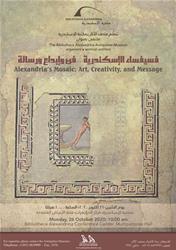Alexandria’s Mosaic: Art, Creativity, and Message
Posted on

The Antiquities Museum, affiliated to the BA Cultural Outreach Sector, organizes a forum entitled "Alexandria’s Mosaic: Art, Creativity and Message" on Monday, 26 October 2020, at 10:00 am, at the Bibliotheca Alexandrina Conference Center, Multipurpose Hall. In this forum, a group of specialized experts will deliver several research papers on this art, its development over the ages, and its restoration methods. Mosaic is the art of ornamenting architectural surfaces using various materials, installed side-by-side on a layer of plaster or smooth mortar, depicting numerous themes. It has been used to decorate large and small spaces, whether floors, walls, ceilings, domes, or fountains in gardens as well.
Due to the importance of mosaics and the strong presence of Alexandrian workshops throughout history and their great wealth of production, Greek artists found many important paintings executed in Egypt, in the homes and palaces of rulers and the wealthy. Meanwhile, the royal court was responsible for the artifacts located in or outside Alexandria. Among the most important paintings found in Alexandria are The Dog and The Wrestlers from the excavations of the Bibliotheca Alexandrina; the Kom Dikka area paintings, such as The Birds, The Tiger, The Flower, The Geometric Shapes, and others; the Abu Qir paintings, be they three dimensional or architectural. Other unique paintings include those that bear the characteristics of the Alexandrian School of Mosaics that has greatly impacted neighboring regions due to the importance of the ancient renowned city. The Alexandrian School executed—and its name appeared on—a number of mosaic paintings outside Egypt, such as the painting of Alexandria in the city of Jerash, and the Map painting in Madaba.
To view the entire program, please click here.